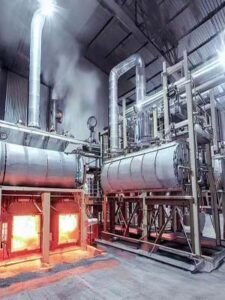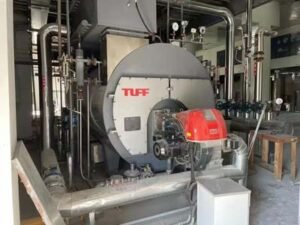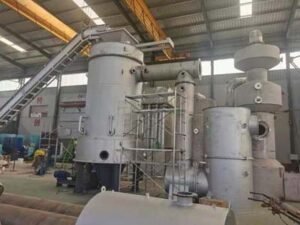In the power industry, kilns are the key equipment to ensure the efficient operation of power generation and related links, and different types of kilns play an important role in their specific application scenarios.

1. Circulating fluidized bed boiler
Circulating fluidized bed boiler is a kind of kiln equipment widely used in power industry. Its working principle is based on the fluidized combustion technology, the fuel (such as coal, biomass, etc.) and the desulfurizer (usually limestone) are sent into the furnace together, under the action of the fluidized wind, the fuel and the desulfurizer are burned in the furnace in a fluidized state.
This combustion method has the significant characteristics of strong fuel adaptability, can burn a variety of different quality coal, including inferior coal, and can effectively control the emission of sulfur dioxide and other pollutants in the combustion process, to achieve desulfurization in the furnace.
The circulating fluidized bed boiler has high thermal efficiency, and the unburned material is separated by the separator and sent back to the furnace for re-combustion, which improves the utilization rate of fuel.
In the field of large-scale thermal power generation and biomass power generation, circulating fluidized bed boilers play an important role in helping to improve the economy and environmental protection of power production, and meet the increasingly strict environmental protection requirements and the needs of diversified energy utilization.

2. Pulverized coal boiler
Pulverized coal boilers occupy a dominant position in traditional thermal power generation. The operation process is to first grind the coal into fine coal powder, and then spray the coal powder into the furnace through a primary air to burn.
Pulverized coal burns rapidly in the furnace, releasing a lot of heat energy, which makes the water in the boiler heated to produce high temperature and high pressure steam, which drives the turbine to generate electricity.
Pulverized coal boiler has the advantages of high combustion efficiency and large power generation, which is suitable for large-scale centralized power generation. Modern pulverized coal boiler adopts advanced combustion control technology, such as low nitrogen combustion technology, which can reduce the generation of nitrogen oxides to a certain extent and reduce environmental pollution.
At the same time, the design and operation of the boiler are continuously optimized, which improves the steam parameters and improves the power generation efficiency, and plays an irreplaceable role in ensuring the stability of the power supply.

3. Waste incinerator
With the increasing demand for waste treatment and energy recovery, the application of waste incinerators in the power industry is gradually increasing. Waste incinerators are specifically used to treat solid waste such as municipal solid waste, and convert organic components in the waste into heat energy through high-temperature incineration, which then generates steam to drive power generation devices.
Common waste incinerators are mechanical grate furnaces, fluidized bed waste incinerators and other types. The mechanical grate furnace uses the mechanical movement of the grate to push the garbage to move in the furnace and gradually burn, which has good adaptability to the garbage, can handle the garbage of different compositions and shapes, and the combustion process is relatively stable.
Fluidized bed waste incinerator uses fluidized air to burn waste in fluidized state, which has the characteristics of high combustion efficiency and fast waste disposal speed. Waste incinerators not only realize the reduction and harmless treatment of waste, but also convert waste into electricity, adding a new source of urban energy supply system, which is of great significance in the coordinated development of resource recycling and environmental protection.
These kilns commonly used in the power industry have their own capabilities under different power generation scenarios and energy utilization strategies, and their continuous development and technological innovation have promoted the power industry towards a more efficient, clean and sustainable direction.
